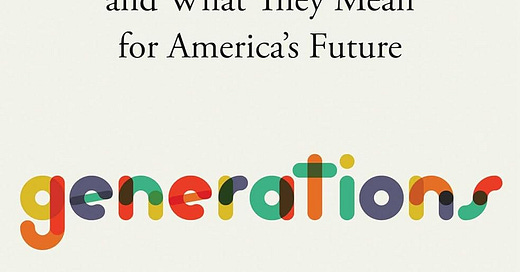Generationally Speaking
Generations: The Real Differences Between Gen Z, Millennials, Gen X, Boomers, and Silents — and What They Mean for America’s Future by Jean M. Twenge
I chatted with one of my favorite 10-year-olds named Jenna the other day. Her age puts her in the youngest generation, called “Alpha” or “Polars.” Me, I was born in the very last year of the Boomer generation, which means there are three generations between Jenna and me (Gen X, Millennials, and Gen Z).
So it shouldn’t surprise me that Jenna asked me a question that I needed her to rephrase three times before I got it. On her last attempt, Jenna said, “Is there anything your college students say that you don’t understand?”
“Oh absolutely!” I responded.
“Like what?” asked Jenna. (Of course she did!) I struggled to come up with a good example, but then just pulled out a word that TV’s Golden Bachelor (a Boomer like me) did not know.
“Rizz,” I said, to which Jenna started laughing hysterically.
“Do you know what that means?” she said in between giggles.
“Yes, it means that someone has charisma — that they have, um, a good personality,” I replied.
“Oh no. Oh NO! It means someone who acts all fake to try to pick someone up. It’s not nice — pleeaase don’t tell your students they have rizz!”
I stand schooled by Jenna.
A much more scholarly analysis of generational differences is provided in Jean M. Twenge’s Generations: The Real Differences Between Gen Z, Millennials, Gen X, Boomers, and Silents — and What They Mean for America’s Future.
I picked up this book after attending a webinar in which Twenge spoke to psychology professors about her work. When I first started teaching, I was in the same generation as my students, if not generation-adjacent. Now that almost four decades have passed, most of my students are in Generation Z. The generational gulf is wide, and I want to do what I can to bridge the distance between me and my students.
The book’s basics
Twenge’s book provides a trove of data on each of the following six living American Generations:
Silents (born 1925-1945)
Boomers (born 1946-1964)
Generation X (born 1965-1979)
Millennials (born 1980-1994)
Generation Z (born 1995-2012)
Polars or Alphas (born 2013-2029)
Within each chapter devoted to a specific generation, Twenge lists data such as the racial and ethnic makeup and famous members of the cohort. In addition, the most popular first names are listed, and interestingly, my name Mary made the list for the Silent, Boomer, and Gen X cohorts. Perhaps this is why when my name is called at the doctor’s office, inevitably three women stand up. Whereas at Starbucks, I don’t need to fight a single soul for my latte when my mobile order is announced.
Twenge then goes on in each chapter to describe a series of traits each generation possesses. The traits describe attributes such as political leanings, thoughts about traditions, stances on social movements, educational attainment, time of marriage and childbirth, size of families, views about career, and much more.
It’s the technology, Boomer . . .
Within all of these interesting comparisons, Twenge makes the main point that what separates generations is not major events that happen (like 9/11 or the crash of ‘08), but rather technological changes that affect how we live our daily lives. She makes the case that technology not only affects our lives directly, but also indirectly through 1) promoting a greater sense of individualism, and 2) something Twenge terms the slow life strategy.
Whereas our society was more collectivistic in nature at the turn of the 20th century, it has slowly become more individualistic due in part to technological advancements. This affects a variety of outcomes such as religious affiliation and a focus on individual rights. Twenge discusses how both collectivistic and individualistic societies have their strengths as well as weaknesses, but asserts that individualism likely will continue to dominate in our society with a host of downstream social effects.
The slow-life strategy describes how people are graduating from school, leaving home, marrying, and having children later in life. Milestones such as having sex and driving a car are occurring later in teens and young adults. I have personally seen the evolution of the slow life strategy in my own family: My mother had her first child at 21, I had my first at 24, and my daughter at age 35 just gave birth to her sweet son Hudson, who was baptized last weekend.
In the book, Twenge quotes a version of the old saw, “If you are not a liberal when you are young, you have no heart, and if you are not a conservative when old, you have no brain.” People who believe this line assume that all generations start out one way in life and end up another. But Twenge’s book does an excellent job of showing how each generation has its own set of experiences that uniquely define their tendencies as a group. It reminds me that my students’ experiences and trajectories are very different from my own, that they are not simply mini-me versions of my Boomer cohort, and that there are benefits and costs of being a part of every generation.
Note: I “read” this book as an audiobook. After about the hundredth time the narrator said, “Please see the accompanying PDF” to view the graphs and charts, I purchased a hard copy of the book and I highly recommend it!





